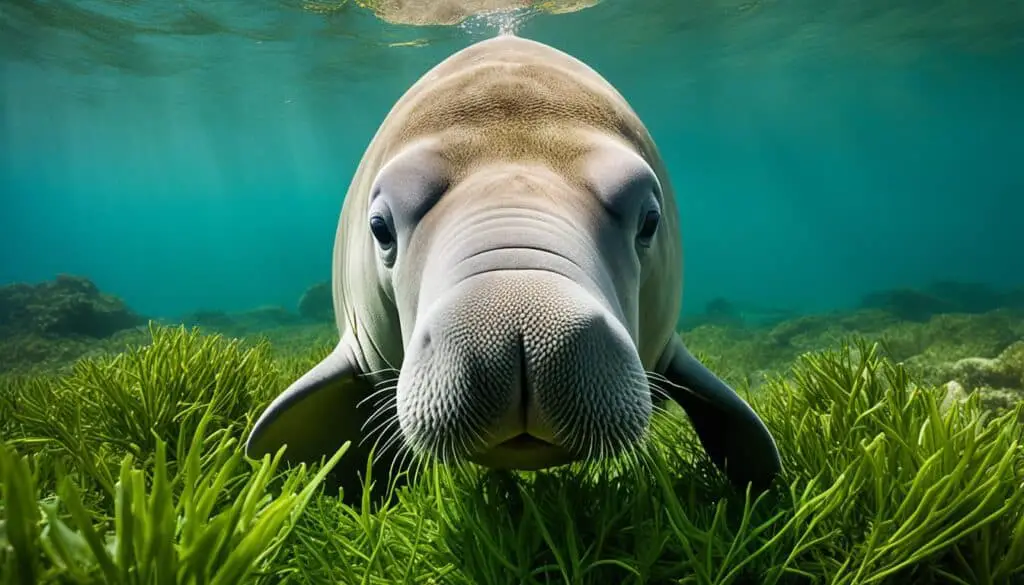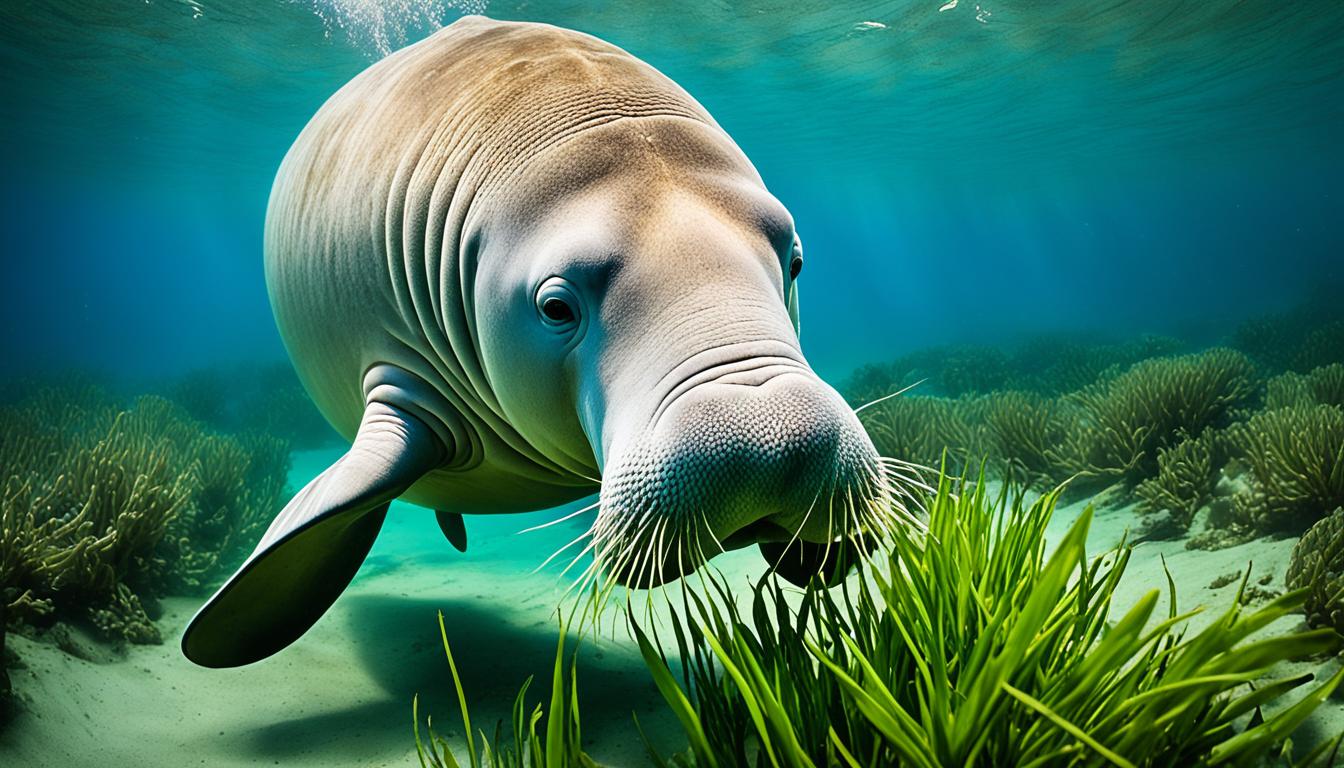Dugongs, known as Dugong dugong, are fascinating marine mammals with unique adaptations. You might ask, how do they adapt to their oceanic homes? These dugong adaptations are crucial to their survival in marine ecosystems. They grow about nine feet long and weigh between 550 to 1,000 pounds. Their size and shape are perfect for eating on the ocean floor.
This article will look into dugong adaptations. We’ll cover their physical traits, behavior, and how they handle environmental changes. By learning about their survival strategies, you’ll see the amazing ways these marine mammals live.
Dugong Adaptations Overview
Dugongs have amazing marine mammal adaptation that lets them live in tough aquatic places. They have evolved dugong adaptations to swim, find food, and avoid predators.
These adaptations fall into three main areas:
- Physical adaptations: Dugongs have big, streamlined bodies for swimming well. Their flippers and tail help them move underwater and live in seagrass beds.
- Behavioral adaptations: Dugongs often hang out in small groups. This helps them find food and keep predators away.
- Physiological adaptations: They have a special digestive system for eating seagrasses. This makes sure they get all the nutrients they need.
Learning about dugong survival strategies shows how they thrive in tough marine worlds. Each adaptation is key to their survival in a changing environment.
| Adaptation Type | Example | Benefit |
|---|---|---|
| Physical | Streamlined body | Efficient movement through water |
| Behavioral | Group foraging | Increased food finding efficiency |
| Physiological | Specialized digestive system | Optimal nutrient absorption from seagrass |
Physical Characteristics of Dugongs
Dugongs have special traits that help them live in the sea. Their down-turned muzzle lets them eat sea grasses efficiently. This feature is key for their survival on the ocean floor.
Their upper lip is strong and covered with fine bristles. These help them find and pull up plants. This shows how dugongs have adapted to find food. They also have smooth skin with little hair, which helps them swim faster.
Dugongs live in shallow coastal waters. Their big, fluked tails help them move quickly through the water. They can hold their breath for about 12 minutes, which is vital for finding food underwater.
| Characteristic | Description |
|---|---|
| Specialized Muzzle | Downward-turned to graze on sea grass |
| Muscular Upper Lip | Covered with sensitive bristles for detecting plants |
| Skin | Smooth with minimal hair to reduce drag |
| Fluked Tail | Assist in propulsion through water |
| Breath-Holding | Can hold breath for approximately 12 minutes |
How do dugongs adapt to their environment?
Dugongs have many adaptations that help them live in the ocean. These adaptations are key to how they interact with their world. They can be split into three main types: behavior, body changes, and how they respond to their environment.
Behavioral adaptations
Dugongs have behaviors that help them survive. They live in small groups for safety and to talk to each other. They know how to eat seagrasses well, picking the best parts for their health.
Physiological adaptations
Dugongs have changed over time to better suit their lives. Their big size lets them store fat for when food is scarce. They can hold their breath for a long time while diving to find food.
They also have special ways to get nutrients from seagrass. This helps them stay healthy.
Environmental responses
Dugongs can change how they live based on their surroundings. They pay attention to water quality and temperature. If their home changes, they can move to find a better place.

Dugong Habitat Adaptation
Dugongs live in specific places, mainly in tropical and subtropical waters. They love shallow coastal areas full of seagrass. This is key for their survival because seagrass is their main food.
These animals are very sensitive to water temperature. They prefer waters above 19 degrees Celsius, perfect for seagrass growth. This helps them find food and stay safe from harsh conditions.
Seagrass habitats are like homes for dugongs, letting them move and eat easily. But, these habitats are under threat from heavy rain and environmental changes. This can reduce food for them. So, dugongs change their habits to find new places when their usual home is not good anymore.
| Aspect | Dugong Habitat Adaptation | Importance |
|---|---|---|
| Water Temperature | Above 19°C | Critical for seagrass growth |
| Habitat Type | Shallow Coastal Waters | Abundance of Seagrass |
| Food Source | Seagrass Meadows | Main source of nutrition |
| Environmental Response | Seek new areas during habitat loss | Adaptive behavior for survival |
Learning about how dugongs adapt shows why we must protect their home. Saving seagrass habitats is key to keeping dugongs alive in our oceans.
Challenges of Dugong Survival
Dugongs, also known as sea cows, are amazing marine mammals facing big challenges. They need our help to survive. Two main threats are habitat loss and getting caught in fishing gear, which harm their numbers worldwide.
Habitat loss and degradation
Habitat loss is a big problem for dugongs. Coastal development, pollution, and climate change hurt their homes in seagrass beds. These beds are crucial for their food. As these areas shrink, seeing a dugong in the wild gets harder.
Loss of seagrass takes away their main food and messes up the ocean’s balance. It’s a big issue for dugongs and the ocean’s health.
Incidental catch in fishing
Getting caught in fishing gear is another big threat. Fishing is important for coastal folks, but it can hurt marine life. Dugongs often get tangled in nets, which can be deadly. This is a big reason why their numbers are going down.
We need better fishing ways that help both dugongs and local communities. It’s about finding a balance for everyone’s benefit.
FAQ
How do dugongs adapt to their environment?
Dugongs have special features that help them live in the ocean. They have a unique nose for eating seagrass and a tail that helps them move. They also live in warm, tropical waters where seagrass grows well.
What are some specific physical adaptations of dugongs?
Dugongs have a special nose that lets them eat seagrass. Their top lip has soft hairs that help them pull up plants. They also have smooth skin and a big tail for swimming in shallow water.
What behavioral adaptations do dugongs exhibit?
Dugongs dive deep to find food and live in areas with lots of seagrass. They use shallow waters to stay safe from predators and changes in their environment.
How do dugongs physiologically respond to environmental changes?
Dugongs change how they dive based on how much seagrass is around. They like warm waters because seagrass grows best there. This is key for their survival.
What challenges do dugongs face in their habitats?
Dugongs face problems like losing their home to coastal development and pollution. They also get caught in fishing gear by accident. These issues make it hard for them to find food and live in their ocean homes.
How important is seagrass for dugongs?
Seagrass is very important to dugongs because it’s most of what they eat. They have adapted to eat these underwater plants. This helps them stay healthy and fed.
What role does temperature play in dugong habitat adaptation?
Temperature is key for where dugongs live. They like warm waters that let seagrass grow well. They stay in places where the water is at least 19 degrees Celsius for plenty of food.







